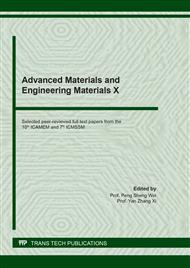[1]
R.S. Mishra, Z.Y. Ma, Sci. Eng. R Rep. 50 (2005) pp.1-78.
Google Scholar
[2]
A. Heidarzadeh, T. Saeid, V. Klemm, A. Chabok, Y. Pei, Mater. Des. 162 (2019) pp.185-197.
Google Scholar
[3]
C. Zhanga, L.Cui, Y.Liua, C. Liua, H. Li, J. Mater. Sci. Technol. 34 (2018) pp.756-766.
Google Scholar
[4]
N. Dialami, M. Cervera, M. Chiumenti, Eur. j. mech. A-solids. 80 (2020) 103912.
Google Scholar
[5]
V.K. Parikh, A.D. Badgujar, N.D. Ghetiya, Mater. Manuf. Process. 34 (2018) pp.123-146.
Google Scholar
[6]
S. Sitthipong, P. Towatana, C. Meengam, S. Chainarong, P.Muangjunburee, Eng. J. 22 (2018) pp.51-64.
DOI: 10.4186/ej.2018.22.3.51
Google Scholar
[7]
L. Kumar, K.U. Yazar, S. Pramanik, Mater. Sci. Eng. A. 754 (2019) pp.400-410.
Google Scholar
[8]
M.H. Mir, B.T. Hassan, J. Nima, Appl. Therm. Eng. 108 (2016) pp.751-763.
Google Scholar
[9]
M. Zhai, C. Wu, H. Su, J. Manuf. Process. 59 (2020) pp.98-112.
Google Scholar
[10]
W. Zhao, C.S. Wu, H. Su, J. Manuf. Process. 56 (2020) pp.967-980.
Google Scholar
[11]
V. Preethi, A.D. Das, Mater. Today Proc. 37(2) (2021) pp.723-727.
Google Scholar
[12]
P. Gulati, D.K. Shukla, A. Gupta, Mater. Today Proc. 4(2) (2017) pp.1005-1012.
Google Scholar
[13]
Y. Mao, Y. Ni, X. Xiao, D. Qin, L. Fu, J. Manuf. Process. 60 (2020) pp.356-365.
Google Scholar
[14]
J. Wannasin, R. Canyook, S. Wisutmethangoon, M.C. Flemings, Acta Mater. 61 (2013) 3897–3903.
DOI: 10.1016/j.actamat.2013.03.029
Google Scholar
[15]
C. Meengam and K. Sillapasa, J. Manuf. Mater. Process. 4(123) (2020) pp.1-20.
Google Scholar
[16]
B. Meyghani, M. Awang, C.S. Wu, J. Adv. Join. Process. 9 (2020) 100007.
Google Scholar
[17]
P. Jedrasiak, H.R. Shercliff, J. Mater. Process. Technol. 263 (2019) 207-222.
Google Scholar
[18]
V. Karami, B.M. Dariani, R. Hashemi, Cirp j. manuf. sci. technol. 32 (2021) pp.437-446.
Google Scholar
[19]
S. Verma, Meenu, J.P. Misra, Mater. Today. Proc. 4(2) (2017) pp.1350-1356.
Google Scholar
[20]
H.H. Jadav, V.Badheka, D.K. Sharma, G. Upadhyay, Mater. Today. Proc. 43(1)(2021) pp.84-92.
Google Scholar


